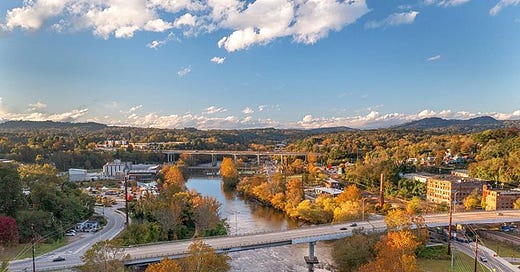
The French Broad River runs through Asheville, North Carolina and, along with the Swannanoa River that joins it just south of town, it’s what caused the catastrophic flooding when Hurricane Helene dumped 18 inches of rain on the surrounding watershed a month ago.
While reading about the flooding and relief efforts in the area, I was surprised to find out the French Broad is considered to be the third oldest river in the world. Older than the Mississippi? Than the Nile? This little river in Western North Carolina?
I wanted to find out more, including how do you “age” a river? I’ve heard that the New River in Virginia is, despite its name, one of the oldest rivers in the world (I’ve since learned the French Broad and New River are in close competition for 2nd and 3rd oldest, with different researchers arguing their places). I grew up along the Nantahala River – is that a “young” river? How can we tell?
How old is the French Broad? How do we even know the age of rivers?
The French Broad begins in Rosman, North Carolina, home of our biggest high school rivals growing up (the Rosman Tigers) as well as Courthouse Falls, which empties into the North Fork of what becomes the French Broad River.

The river continues for 219 miles before emptying into the Tennessee River then the Mississippi River and eventually the Gulf of Mexico. Four thousand miles of tributaries contribute to its waters, including the Pigeon, Nolichucky, and Swannanoa Rivers, all of which may sound familiar as they caused massive flooding from Hurricane Helene (the Nolichucky flooded Erwin, TN causing people to be evacuated from the rooftop of their hospital).
The French Broad cuts through the Appalachian Mountains from south to north as it travels to the Tennessee River. A northern-flowing river, I found out, is not as unusual as we tend to think it should be. Several websites described it as “one of the few” rivers that flows to the north, but it turns out many rivers do, including the Nile. Rivers flow from a higher place to a lower place, regardless of where the equator is or how we’ve chosen to orient ourselves to our planet’s place in space. Ever since a few hundred years ago, when Mercator’s map defined how we see the world on a map, we decided North was best placed at the top of maps. Our sense of gravity fools us into thinking water must flow from north to south because, hey! North is higher than south, right? Humans. We’re very silly.
At any rate, the fact that the French Broad slices through the Appalachians (regardless of whether it’s towards the north) turns out to be important for determining its age. Rivers are “aged” by examining the age of the land that surrounds them. The French Broad flows through extremely old valleys. But even more importantly, it’s very possible the river itself is older than the Appalachian Mountains surrounding it.
To illustrate: I found a really cool website that allows you to follow a droplet of water from any spot in America to its final ocean destination. When I dropped water into Rosman, it quickly flowed towards Asheville and then sliced through the mountains to the north on its way to Tennessee:
Geologists believe the French Broad has flowed through this land for eons – even before the Appalachians were formed. The river appears to predate the Alleghanian orogeny, the geological event that caused the formation of the Appalachian Mountains around 300 million years ago. When rivers fully dissect a mountain range, it’s believed the mountains rose up around the river. The New River also slices through the Appalachians, which is why it competes with the French Broad for the “oldest American river” title.
Another important point: the French Broad is pretty wide and meandering, another indication that it’s been around a while. Older rivers tend to have lots of “meanders” or “oxbows,” which are crescent-shaped curves in the river that echo the changes in its riverbed over many years.

Older rivers tend to be slow and fairly calm because they aren’t descending down steep mountainsides -- they’re done with all that whitewater silliness that young rivers are into. Old rivers also tend to be muddier because they carry more silt in their slow-moving waters.
Thus, the narrower, fast-moving Nantahala River on which I grew up is clearly a “young” river when compared to the French Broad or the New Rivers.
The Nantahala River formed after the Appalachians arose since it is the force that created the Nantahala Gorge through a process called “stream capture” that I’ve written about before.
So, it’s fair to say that if a river near you is wide and muddy, slow-moving and meandering, it’s likely an older river. But to truly tell its age, we have to know more about the land it’s moving through. The Mississippi River is believed to be less than 40 million years old because it was born after the Rockies were formed. It’s a big river and has an enormous number of tributaries feeding it, but the land surrounding it is much younger than the Appalachians.
The Nile is thought to be around 65-75 million years old – it came into being around the time the dinosaurs went extinct. Which really puts into the perspective the age of the French Broad – at approximately 340 million years old, the river predates the dinosaurs. The world at that time was a humid swamp and the first amphibians had just evolved to begin to poke their heads out of the sea. The continent Gondwana was moving toward the North American/European continent, about to collide to create the Appalachian Mountains as part of the Alleghanian orogeny mentioned above.

The map above shows the world sometime after Gondwana has slammed into the continent to form the Appalachians, which appear in yellow. And somewhere, squished in between those yellow mountains, is the baby French Broad. Or perhaps it was an adolescent at this point. Either way, this river has seen some things. From emerging amphibians to dinosaurs to indigenous peoples to current-day humans playing with plastic boats in its waters.
Last month’s flood is the tiniest blip in the French Broad’s overall existence. The river will continue to be. And so will we.
The school at which I work is collecting books and stuffed animal “reading buddies” for the students of the elementary school in Swannanoa, North Carolina. The town was devastated by the flooding of the Swannanoa River, a tributary of the French Broad – many people lost their homes and most of the businesses in the town were washed away or gutted and filled with mud.
Our school’s families will be buying books and writing encouraging messages on the inside covers for the Swannanoan students. We’re calling it Books-giving and Blessings, and if you are interested in contributing we have a wishlist of books on Amazon that you can find here or using the QR code below. We can have our students write an encouraging note on the inside of any books you purchase (books are sent directly to our school when you buy on Amazon) or if you want a specific message written in a book, just reply to this email and tell me which book/s you bought and what you’d like me to write on the inside. Thank you in advance for any contributions you can make!
Weird Nature:
(click to watch)









It is beyond amazement that the 2 oldest rivers in the world flow through North Carolina. The oldest, of course, being the Finke River in Australia, 2nd is the New River, 320 miles long, which flows alongside highway 16 south of West Jefferson on it's way from W. V. so I was excited to read today that we have the 3rd oldest river also! I was not aware the French Broad was the 3rd oldest. This is truly fabulous to know.
Absolutely fascinating! I feel very much like your river: old and slow moving! This is a great essay.